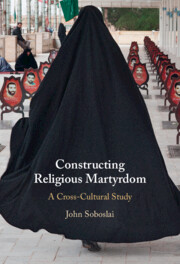Book contents
- Constructing Religious Martyrdom
- Constructing Religious Martyrdom
- Copyright page
- Dedication
- Contents
- Acknowledgments
- Abbreviations of Ancient Sources
- 1 Introduction
- 2 Executed Martyrs in Second-Century Christianity
- 3 The Human Bombs of Twentieth-Century Shi’i Islam
- 4 Sikh Martyr Imaginaries during World War I
- 5 Twenty-First-Century Tibetan Self-Immolators
- 6 Performances of Suffering
- 7 Witnesses to a Sovereign Imaginary
- Epilogue
- Bibliography
- Index
4 - Sikh Martyr Imaginaries during World War I
Published online by Cambridge University Press: 07 June 2024
- Constructing Religious Martyrdom
- Constructing Religious Martyrdom
- Copyright page
- Dedication
- Contents
- Acknowledgments
- Abbreviations of Ancient Sources
- 1 Introduction
- 2 Executed Martyrs in Second-Century Christianity
- 3 The Human Bombs of Twentieth-Century Shi’i Islam
- 4 Sikh Martyr Imaginaries during World War I
- 5 Twenty-First-Century Tibetan Self-Immolators
- 6 Performances of Suffering
- 7 Witnesses to a Sovereign Imaginary
- Epilogue
- Bibliography
- Index
Summary
In Chapter 4, the third case study investigates how martyrdom discourse was deployed by Sikhs during World War I. It begins with an analysis of the social and cultural situation at the turn of the twentieth century in Punjab, from where the majority of Sikh sepoys hailed, and the resulting relationships with the imperialist British Raj. After examining the socioeconomic conditions that led Sikhs to enlist in the British Indian Army, I discuss how a military mindset constructed a particular idea of Sikh character. The chapter proceeds with an analysis of Sikh traditions of martyrdom and the way the British Empire was colored as a prophesized entity, and therefore actions in its service construed as a sacred duty. Simultaneously, I describe the antagonism felt for the British Empire by emigrant Sikh communities especially in North America, creating a bifurcation of perspectives reflected in approval or dismissal of the self-sacrifice of Sikh soldiers and the creation of anticolonial martyr forms. The chapter concludes with an examination of how the failed promises of the British government following the war marginalized those Sikh martyrs who fell in their ranks during World War I.
Keywords
- Type
- Chapter
- Information
- Constructing Religious MartyrdomA Cross-Cultural Study, pp. 218 - 271Publisher: Cambridge University PressPrint publication year: 2024

